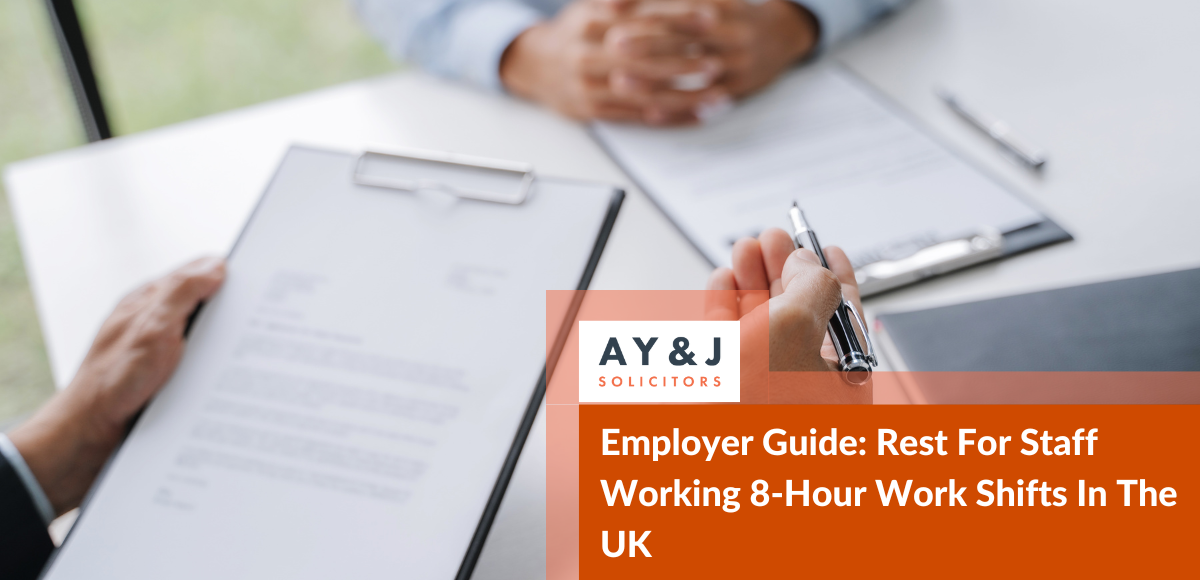Disclaimer: The information in this blog is accurate as of its publication date. Any updates after that date are not reflected here.
Employers in the United Kingdom must provide rest breaks to employees working shifts longer than six hours. This requirement follows the Working Time Regulations 1998. The aim of this law is to ensure the safety and well-being of staff in the workplace. All businesses and companies with staff must understand and follow these rules. Any breaches can lead to serious legal consequences. These penalties can include unlimited fines and up to two years of imprisonment for directors. The Health and Safety Executive (HSE) may also issue improvement or prohibition notices. In this guide, we will explain all that employers need to know about providing breaks for staff working 8-hour work shifts in the UK.
Table of Contents
Working Time Regulations 1998: Mandatory breaks
The Working Time Regulations 1998 set out three types of Rest Breaks in the workplace:
- During the working day – employees must have a 20-minute rest break during the working day if working a shift exceeding 6 hours.
- Between working days – employees must have a break of at least 11 hours between the time they finish work and start work on the following day.
- Between working weeks – employees must also have a 24-hour break every 7 working days of work or 48 hours every 14 days of work.
Employees in the UK are entitled to an annual holiday entitlement. These rules apply to all employees, including agency workers, apprentices, and seasonal workers. They also cover doctors in training and zero-hours workers. However, the rules differ for those working at night and those under the age of 18 who have yet to finish school. Crucially, each type of rest/break has its own legal requirements and implications, as explained below.
Rest Breaks during the working day
Regulation 12 of the Working Time Regulations 1998 states that workers with a daily working time of more than six hours are entitled to a rest break during their working day. The rest break provided must be for an uninterrupted period of not less than 20 minutes. The Working Time Regulations 1998 also allow workers to take a break away from their workstations if they have one.
Workers in the UK often take a lunch or tea break during their 6–8 hour shift. This break counts as a rest break. Rest breaks should not be taken at the end of the shift; rather, they should preferably be at the approximate halfway point through the shift so that the employee has the greatest benefit from the break.
To comply with this law, employers must ensure that breaks are free from work interruptions. Employees should not face any demands during this time.
Important notes:
- The regulations define the minimum break time for employees working over six hours. Employers can choose to offer more generous breaks.
- An employer does not have to provide paid rest breaks unless stated in the contract or agreement. They must follow any agreed terms. That said, most employers do pay staff for rest breaks.
- Employers should consider the type of work that their employees do, including if they undertake heavy or repetitive work and/or work that requires high levels of concentration. For example, air traffic controllers typically require longer and more frequent breaks from their workstation.
- The rest break rules differ for young workers. A young worker is one who is aged under 18 but has reached school leaving age (bear in mind that the school leaving age differs across the UK). If a young worker’s daily working time is more than four and a half hours, they must have a rest break of at least 30 minutes. The break should be for a consecutive amount of time and not broken into smaller amounts. Again, young workers can take this rest time away from their workstation if they have one.
Rest Breaks between working days
Regulation 10 of the Working Time Regulations 1998 states that employees are entitled to a minimum amount of daily rest between when they finish their working day and starting their next on the following day. The minimum break between working shifts is 11 consecutive hours in each 24-hour period of working for an employer.
The 11-hour daily rest break ensures sufficient time between shifts. A worker finishing at 5 pm must not start before 4 am the next day.
Important notes:
- If an employer cannot provide the required daily rest break due to a workplace emergency, they must compensate for it later. They should offer a break as soon as possible.
- Young workers must have a longer rest break of 12 hours within each 24-hour period between working days..
Rest Breaks between working weeks
Regulation 11 of the Working Time Regulations 1998 states that employees must also be given a weekly rest period. Specifically, they must have:
- An uninterrupted rest period of a minimum period of 24 hours every seven days of work or
- An uninterrupted rest period of a minimum period of 48 hours every 14 days of work.
The aim of this rule is to enable staff to have time away from work to properly recover and spend time away from work activities.
Important notes:
- Young workers must receive an uninterrupted rest period of at least 48 hours every seven days of work. OR
- Employees can take the 48 hours of rest as a single 48-hour block or two separate 24-hour blocks.
- The minimum weekly rest period must not include any part of a daily rest period regulation 10 of the Working Time Regulations. The only exception occurs when avoiding it is impossible for objective or technical reasons. It also applies to essential work organization needs.
Also Read – EMPLOYER CHECKING SERVICE (ECS) – HR QUICK-REFERENCE GUIDE










